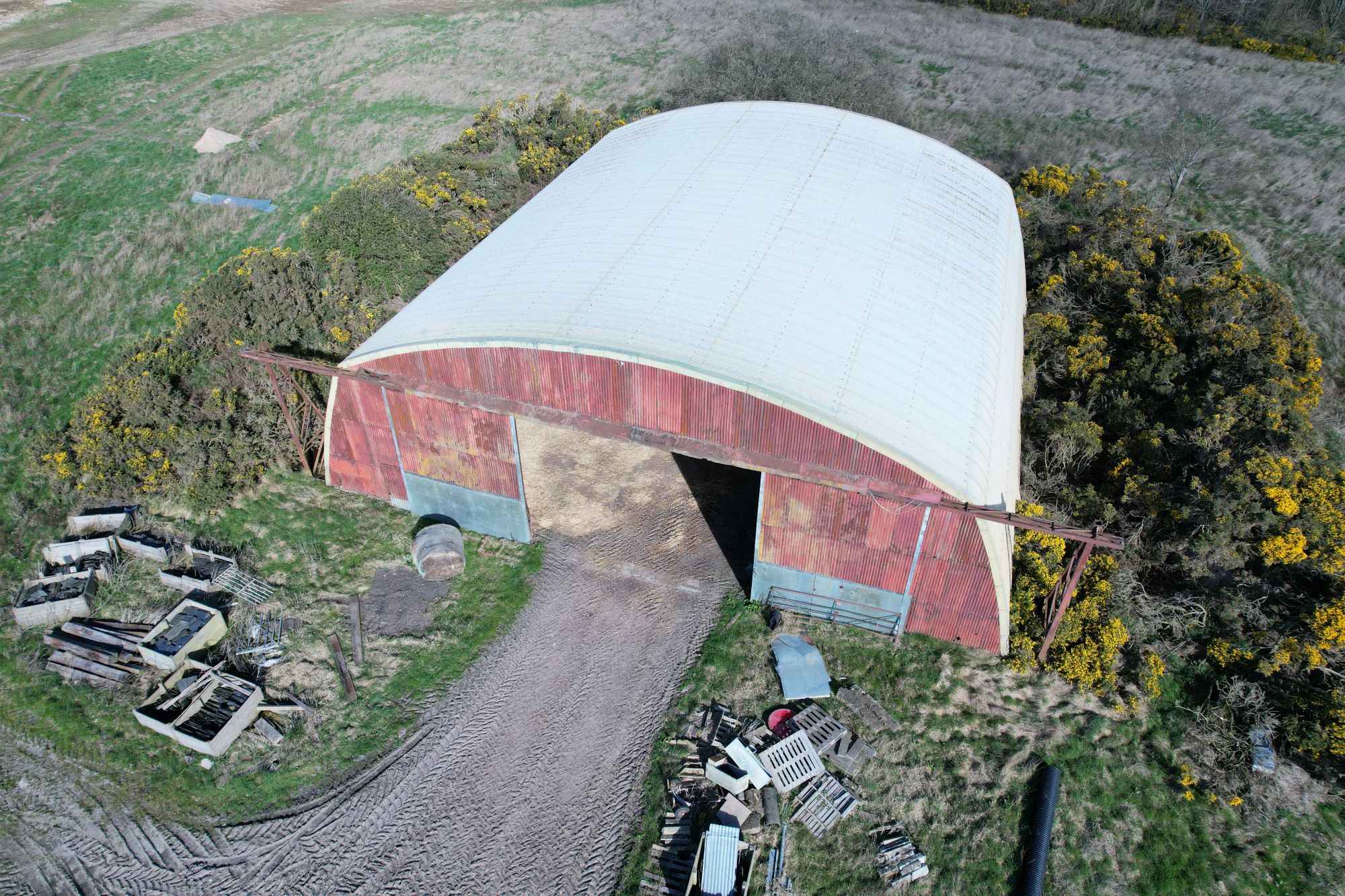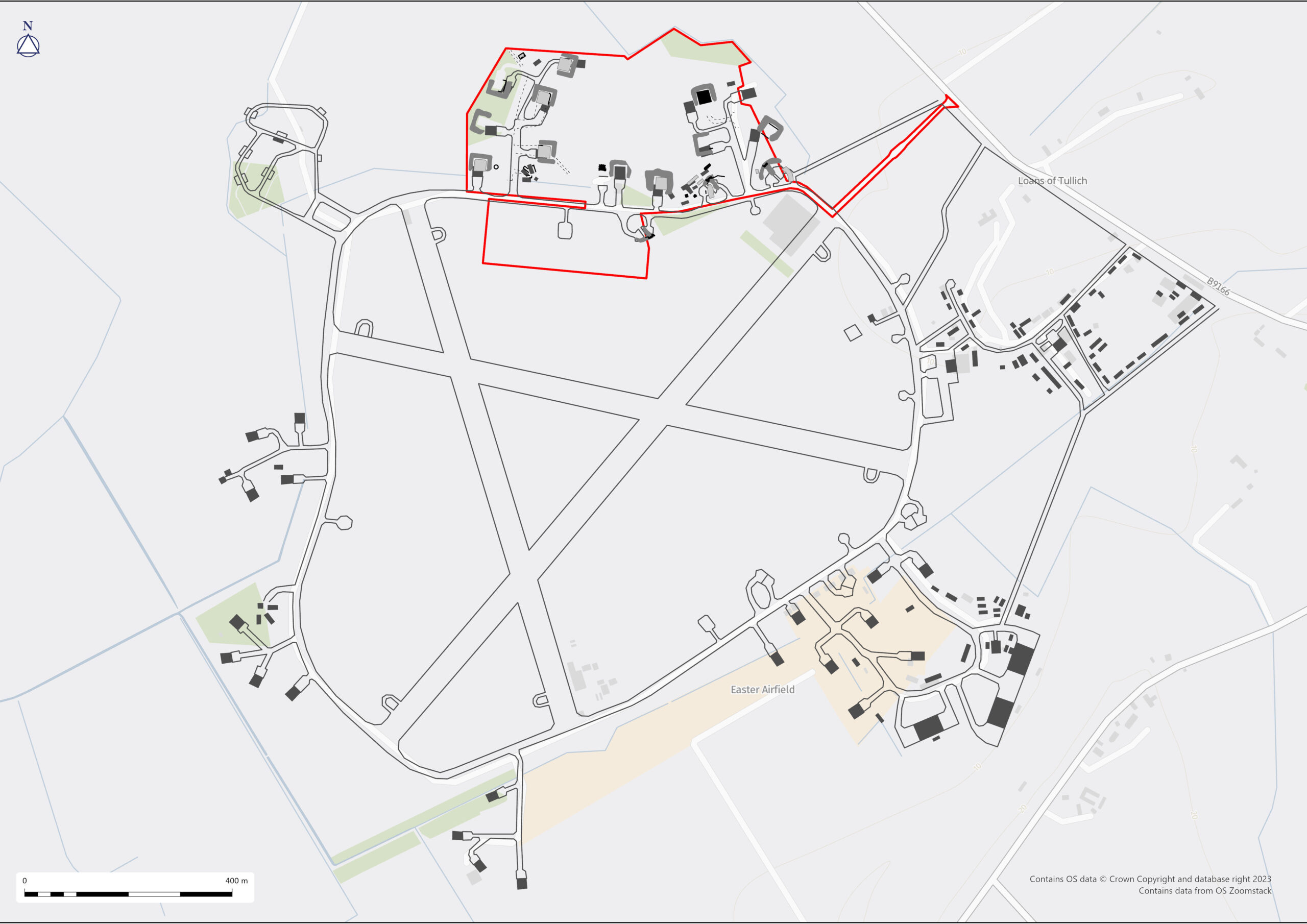During World War Two, Fearn Airfield (also known as HMS Owl) was one of Britain’s most important naval airbases. Recent development works have provided an opportunity to investigate some of the historic bunkers, hangars, and military buildings through archaeological evaluation and 3D recording.
The works were undertaken on behalf of Glenmorangie Distillery and Blyth and Blyth.
Archaeological Survey and Evaluation
Between November 2021 and April 2023, archaeological survey and evaluation took place on the northern edge of the airfield ahead of development. The area contained the Stop Butt building, an aircraft hangar, several bomb shelters, an old barracks block, and numerous blast shelter banks around previously demolished hangars. Evaluation trenches uncovered the buried remains of building and hangar foundations. Metal detecting was undertaken over the trench locations by archaeologists and a UXO specialist, and although few artefacts were found, a stash of training bombs was uncovered. Detailed survey of a Bellman hangar and two air raid bunkers was carried out using laser scanning and a 3D model of the Stop Butt was created using photogrammetry techniques.
Use your mouse to explore the 3D model showing part of the Airfield. Can you find the Bellman Hangar, a barracks block, two air raid shelters, and a blast shelter?
The Stop Butt
The Stop Butt, also known as a firing butt, was a specialised building designed for testing aircraft cannons and machine guns. The front of the building was open, allowing aircraft to fire into the building, which would have been filled with sand to absorb the impacts. The side and rear walls were buttressed to withstand the pressure from the sand and explosive impacts.
explore the 3D model⚬
explore the 3D model⚬
explore the 3D model⚬
explore the 3D model⚬
explore the 3D model⚬
Air Raid Bunkers

There are several air raid shelters around the airfield, which would have provided cover for military personnel in the event of an air raid. The shelters are reinforced concrete bunkers covered over by curving T-shaped earthwork banks, each with three brick entrance corridors. They appear to be Stanton-style air raid shelters, suggesting that the concrete sections were pre-made elsewhere before being transported to the site and bolted into position. The concrete chambers would have offered great structural strength, while the multiple entrances allowed for emergency exits in the event of collapse. Using laser scanning, the archaeologists were able to create 3D models showing the structure of the bunkers underneath the earthwork mounds, as shown in the images here.

Bellman Hangar

Aircraft hangars were built in several groups around the perimeter track to house the current aircraft stationed at the airfield. Bellman Hangars were a style of portable hangar with a simple construction system allowing it to be erected or dismantled by unskilled workers. The hangars were each protected by a U-shaped earthwork bank. This example was the last remaining at the airfield, but many of the blast protection banks from other, previously dismantled, hangars remained.
HMS Owl – Fearn Airfield
Fearn Airfield opened in late 1941 as a satellite to the nearby RAF base at Tain Airfield. It was only minimally used by the RAF and in 1942 was transferred to the Royal Navy and commissioned as HMS Owl. Throughout the Second World War, numerous Fleet Air Arm squadrons made use of the base and from 1943 onwards it was used primarily as a torpedo training school for Barracuda aircraft. Other aircraft flown from the base included Avro Ansons (for radar training), Fairey Swordfish, and Fairey Fireflies. At its peak, the base had around 3000 men and women stationed there. It was even visited by the New Zealand Prime Minister in June 1944. By 1946, all naval units had disbanded or moved, and the airfield was handed back to the RAF who used it as a satellite landing ground for Dalcross during the 1950s.
Airfield Layout
Fearn Airfield contained three runways connected by a 40ft wide perimeter track. When the Navy took it over, they added five hardstandings and groups of Bellman Hangars, as well as replacing the original control tower with the three-storey tower that still stands today. Other buildings around the airfield included bomb shelters, accommodation and toilet blocks, workshops, a radar test base, explosives area, pens, and a stop butt.
Below is the area of archaeological works shown on a map alongside the 1942 layout of the airfield. You can view the original Royal Navy plan at the Royal Navy Research Archive.


828 Squadron at HMS OWL in April 1944
Standing, left to right: “Hurric” Ian Kirton, Bruce Turner, “Joe” Hunt, Tony Bateman, “Sam” Strong, “Walford” Davis, “Copper” Porter, “Dicky” Bird, Mick Williamson, Cyril Price, “Finger” Foulkes, “Lash” Williams, Basil Green, Stan Still, Maurice Taylor, Wing.
Seated, left to right: George Wisden, “Oli” Oliver, Huth, “Stripey” Martin, Lt/Cdr Swanton (& Schlumpie), Jack Stokes, Tony Lacayo, “Yours Aye” Douglas Smith, “Jock” McKean.
Copyright © Rob Dalziel / Cromarty Archive. Original source: https://www.thecromartyarchive.org/picture/number2444
The People of the Airfield

817 Squadron Barracuda Crew
Back row left to right: Don Grant (pilot), ? Mackenzie, Telegraphist Air Gunner. Front row: airframe and engine mechanics.
Copyright: © Iain Crosbie / Cromarty Archive. Original Source: https://www.thecromartyarchive.org/picture/number2369

NEW ZEALAND PREMIER VISITS ROYAL NAVAL AIR STATION. 21 JUNE 1944, ROYAL NAVAL AIR STATION FEARN, SCOTLAND. THE VISIT OF MR BRUCE FRASER, THE PRIME MINISTER OF NEW ZEALAND TO THE ROYAL NAVAL AIR STATION AT FEARN. (A 24605)
Left to right, back row: Lieut Wilson, RNZNVR, and two boyhood friends of Mr Fraser. Middle row: a New Zealander who is working on the aerodrome; Captain Robertson, Commanding Officer of the Station; a War Correspondent; Mrs Robertson; Mr Fraser; Mrs Fraser; Sub Lieut Goodwin, RNZNVR; Lieut White, DSC, RNZNVR; Mrs Montgomery; Lieut Cdr Montgomery, RNZNVR; Mrs Bassett; Lieut Cdr Bassett, RNZNVR. Copyright: © IWM. Original Source: http://www.iwm.org.uk/collections/item/object/205156459

































